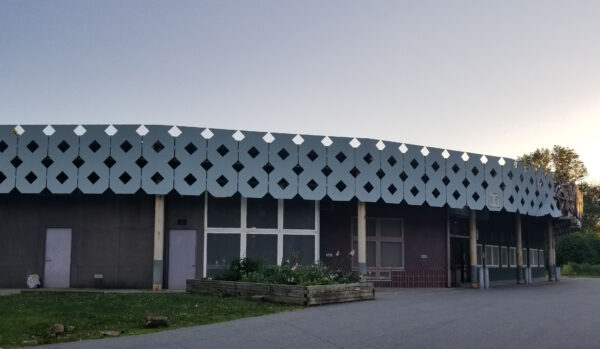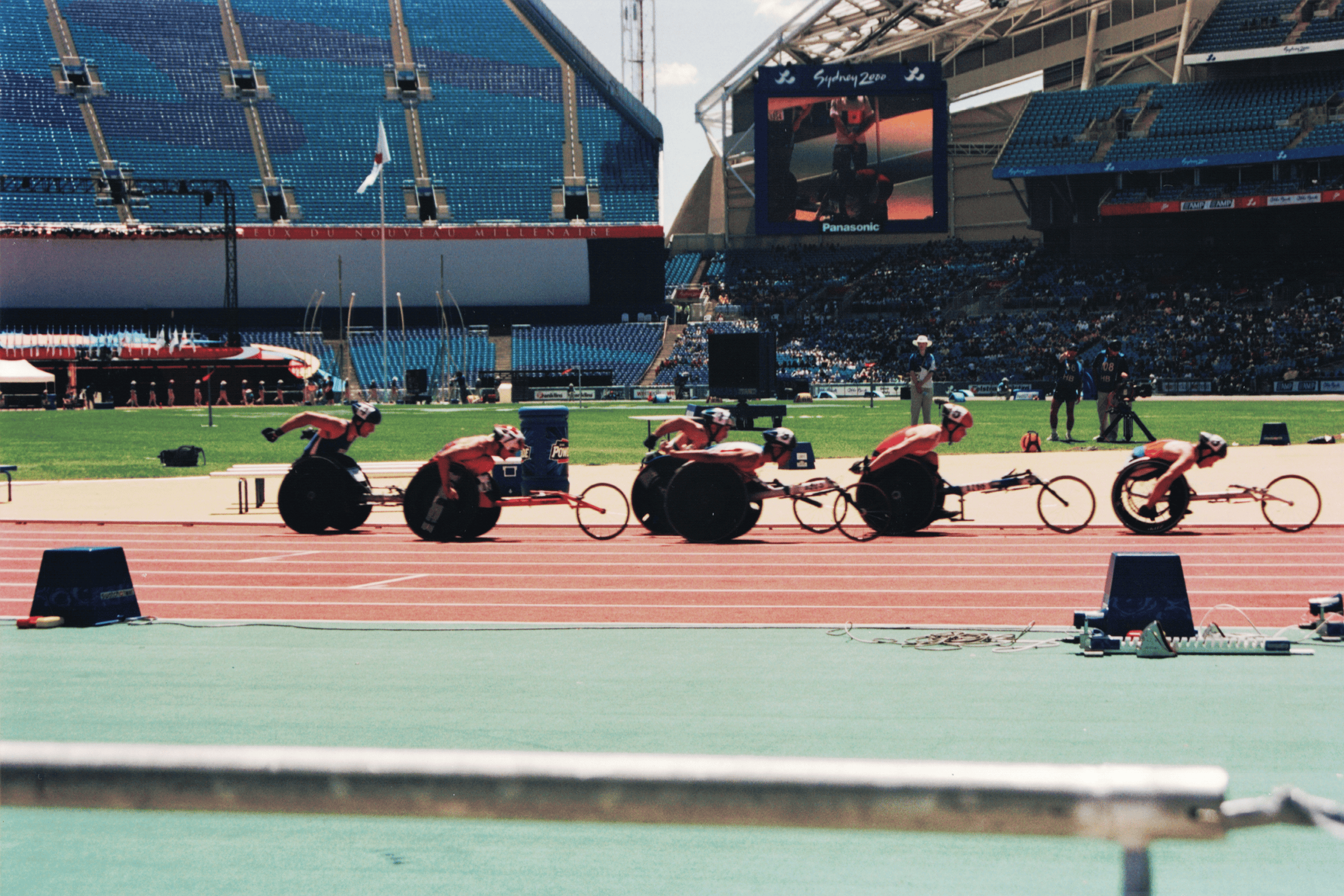For a building that frequently hosts basketball tournaments and summer camps, the Carousel House was quiet when I arrived for a tour in the summer of 2018. The first recreation center designed specifically for disabled people, the building had visibly aged; its once bold latticework facade was peeling from the building, revealing rusty supports.

The Carousel House in Philadelphia, photographed in 2018. Deanna Hagman
I visited as research for my undergraduate capstone in interior design to learn what spaces for disabled people looked and felt like. I had not yet learned the language of crip theory or disability history, but I knew this: Space shapes experiences, not only how it looks or functions, but who it is for and how it makes people feel. Inside, the manager on duty confirmed the urgent need for repairs. Stuck on a long backlog with Philadelphia Parks and Recreation, the Carousel House community was making do with the aging building. While imperfect, until safety concerns during the COVID-19 pandemic led Carousel House to shut its doors, it was a place of belonging.
Built in 1987, architect Richard Conway Meyer designed the facility at a time when few formal accessibility guidelines existed. The building was full of details that signaled care. Modeled after a carousel that once sat nearby in Fairmount Park, its round form was meant to imply inclusion. Circulation paths were broad and patterned to help orient visitors; doors swung both ways; signage used large print and braille; there were emergency call buttons in each room. Its pool was especially innovative: the floor could rise and lower, easing swimmers into the water without a lift. The building was not without flaws. It was difficult to furnish, lacked safety sightlines, and was reliant on fans and open windows for airflow. Yet it was alive. Users planted a garden, painted murals, and filled the rooms with music, dance, martial arts, sports, and club meetings.
To understand the significance of Carousel House, we must recall that historically, to be disabled was to be denied space. Cities were designed with the assumption of ablebodiedness. Curb cuts to accommodate wheelchairs (along with strollers, carts, and skateboards) didn’t exist until 1945. Stairs barred countless public entrances, elevators were rare, and transit systems often excluded disabled riders. Inaccessible classrooms, restrooms, and polling places repeatedly sent the same message to disabled Americans: this place is not for you.
The building was full of details that signaled care.
Such exclusion was not incidental but systemic, reinforced through policy, design, and stigma. The industrialization of the 19th century ushered in wage-based labor and put a cultural premium on productivity. Where once disabled people were essential parts of household economies or local trades, they became cast as burdens on their families and society. This trend was only compounded by the rise of eugenics, which pathologized disability and justified institutionalization, segregation, and the removal of disabled people from public space. “Ugly laws,” ordinances that banned “unsightly” people from appearing in public, survived in some places into the 1970s. Even after the passage of the Rehabilitation Act of 1973 and the Americans with Disabilities Act of 1990, compliance often lagged behind rhetoric.
In this context, spatial access became a central site of resistance. Student activist Ed Roberts’s demand in 1962 to live on the University of California, Berkeley, campus sparked the formation of the first Center for Independent Living (CIL). The CIL model, led by disabled people for disabled people, offered peer support, housing advocacy, and access tools, while also insisting on dignity, culture, and self-determination. Camp Jened, a summer camp for disabled children, became a formative space for future activists like Judith Heumann, who later led the 504 Sit-In in 1977. Across the country, arts collectives, sports leagues, and activist headquarters flourished. Wheelchair basketball, originally designed as rehabilitation for World War II veterans, grew into community tournaments and international competition. At Carousel House, those same games played out, rooting global movements in local space.
Other interventions were quieter but no less vital. Phone trees, letter-writing campaigns, informal care webs, and later online forums and listservs all helped sustain everyday life when institutions failed. Projects like Alice Wong’s Disability Visibility Project turned digital space into archives, ensuring that disabled voices were seen and preserved. Such projects aren’t just about connection. They are about claiming space—online, in the archive, and in public discourse. Still, brick-and-mortar sites like the Carousel House matter. They provide a space for disabled people to enjoy, with a garden to tend, a pool to swim in, a gym to play in. These spaces show that resistance evolved from survival strategies to also finding sites of joy, culture, and imagination. The success of Carousel House and other accessible community centers reflect what disabled people have long known: community is not optional.
The closure of Carousel House came as the pandemic underscored the fragility of public infrastructure and the importance of connection. In 2021, a long-awaited city inspection deemed Carousel House unsuitable for repairs, and it was slated for demolition. The decision sparked community protests, which demanded a replacement so as not to leave a vacuum for local disabled citizens. City officials pledged to rebuild a bigger and better facility, now led by the Rebuild Initiative, with the promise of being “inclusive for all.” But in fact, many community members were initially excluded from planning conversations, and early reports indicated the new approach would not replicate the Carousel House model. Instead of providing a dedicated and specialized space, accessible programs would be dispersed among existing recreation facilities citywide as part of broader upgrades.
The closure of Carousel House came as the pandemic underscored the fragility of public infrastructure and the importance of connection.
While laudable in theory, such efforts are slow and uneven, leaving behind those who once relied on a dedicated, specific space. “Inclusive for all” is a powerful phrase. But it raises a deeper question: what happens when inclusion becomes so generalized that it excludes the very people a space was originally built for?
Construction on the new facility was due to begin in 2025, but as of this writing, the city has provided no direct updates in over a year. The community that once swam, played, and organized at the Carousel House waits without a sufficient substitute. A space that once belonged to them has been rebranded for everyone—and in the process, for no one in particular. This is not just about one building. It is a story about the politics of space and what is lost when we trade specificity for universality. In remembering the Carousel House, we must ask what kinds of spaces we still need to build for each other and for the futures we want to hold.
Deanna Hagman is a history MA student at Villanova University with a concentration in public history.
This work is licensed under a Creative Commons Attribution-NonCommercial-NoDerivatives 4.0 International License. Attribution must provide author name, article title, Perspectives on History, date of publication, and a link to this page. This license applies only to the article, not to text or images used here by permission.

